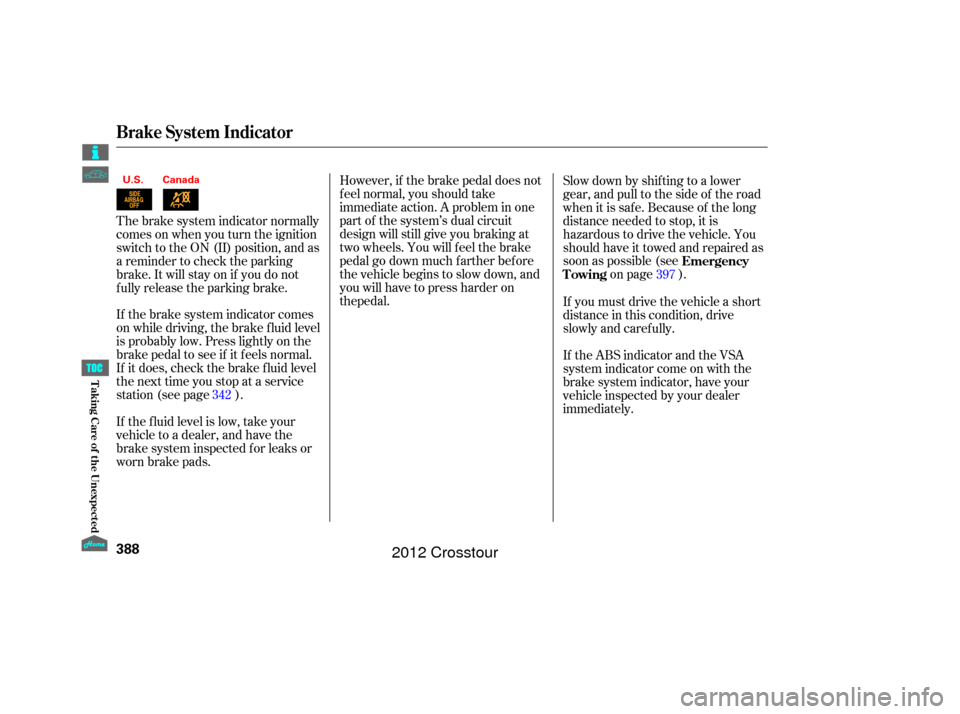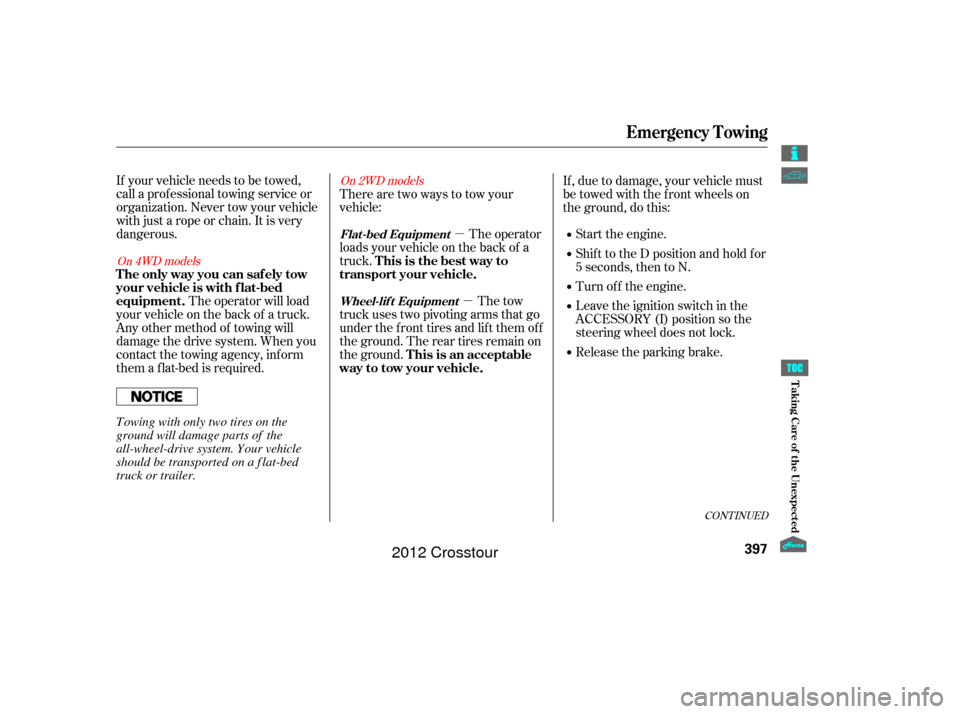Page 379 of 435
CONT INUED
Placethejackunderthejacking
point nearest the tire you need to
change. Turn the end bracket
clockwise until the top of the jack
contacts the jacking point. Make
sure the jacking point tab is
restinginthejacknotch.
Loosen each wheel nut 1/2 turn
with the wheel nut wrench.
To reinstall the spare tire holder,
slide the hook, lift up the spare
tire holder and attach it to the
hook. Attach the longer section of
the wrench to the spare tire
holder shaft. Turn the wrench
clockwise. Then attach the short
end of the wrench to the shaft,
and tighten it securely.
Reinstall the plastic cover.
11. 10.
12.13.
Changing a Flat Tire
375
WHEEL NUT
JACKING POINTS
T aking Care of t he Unexpect ed
2012 Crosstour
Page 380 of 435
Before mounting the spare tire,
wipe any dirt off the mounting
surface of the wheel and hub
with a clean cloth. Wipe the hub
carefully; it may be hot from
driving.
Use the extension and the wheel
nut wrench as shown to raise
the vehicle until the flat tire
is off the ground.
Remove the wheel nuts, then
remove the f lat tire. Handle the
wheel nuts caref ully; they may be
hot from driving. Place the flat tire
on the ground with the outside
surface facing up. Lower the vehicle to the ground,
and remove the jack. Put on the spare tire. Put the
wheel nuts back on f inger-tight,
then tighten them in a crisscross
pattern with the wheel nut wrench
until the wheel is f irmly against
the hub. Do not try to tighten the
wheel nuts f ully.
14.
15. 16.17.
18.
Changing a Flat Tire
376
BRAKE HUB
WHEEL WRENCH EXTENSION
T aking Care of t he Unexpect ed
2012 Crosstour
Page 381 of 435
CONT INUED
Store the jack and tools in the tool
kit case.
Replace the utility box. Remove
the hook and close the removable
tray.
Put the flat tire into the plastic bag,
whichisstoredinthetoolkitcase.
Knot the top of the plastic bag.
Tighten the wheel nuts securely in
the same crisscross pattern. Have
the wheel nut torque checked at
the nearest automotive service
f acility.
Tighten the wheel nuts to:
19.
20.21.
22.
Changing a Flat Tire
377
PLASTIC BAG
TOOL KIT CASE
HOOK
REMOVABLE TRAY
80 lbf·ft (108 N·m , 11 kgf·m)
T aking Care of t he Unexpect ed
2012 Crosstour
Page 382 of 435
Place the flat tire in the cargo area,
and thread the belt through the
cargo hook as shown in the
illustration. Pass the belt through
the ring, and tighten the belt to
secure the f lat tire in place.
Bore through the bag, and pass
the holding belt through the hole
of the bag and the wheel of the flat
tire as shown in the illustration.
This belt is with the bag in the tool
kit case.
23.
24.
Changing a Flat Tire
378
BELTCARGO HOOK
Loose items can fly around the
interior in a crash and could
seriously injure the occupants.
Store the wheel, jack, and tools
securely before driving.
T aking Care of t he Unexpect ed
2012 Crosstour
Page 392 of 435

However, if the brake pedal does not
f eel normal, you should take
immediate action. A problem in one
part of the system’s dual circuit
design will still give you braking at
two wheels. You will feel the brake
pedal go down much f arther bef ore
the vehicle begins to slow down, and
you will have to press harder onIf you must drive the vehicle a short
distance in this condition, drive
slowly and caref ully. Slow down by shif ting to a lower
gear, and pull to the side of the road
when it is saf e. Because of the long
distance needed to stop, it is
hazardous to drive the vehicle. You
should have it towed and repaired as
soon as possible (see
on page ).
The brake system indicator normally
comes on when you turn the ignition
switch to the ON (II) position, and as
a reminder to check the parking
brake. It will stay on if you do not
f ully release the parking brake.
If the brake system indicator comes
on while driving, the brake f luid level
is probably low. Press lightly on the
brake pedal to see if it f eels normal.
If it does, check the brake f luid level
thenexttimeyoustopataservice
station (see page ).
If the f luid level is low, take your
vehicle to a dealer, and have the
brake system inspected f or leaks or
worn brake pads. If the ABS indicator and the VSA
system indicator come on with the
brake system indicator, have your
vehicle inspected by your dealer
immediately.
342 397
Emergency
Towing
Brake System Indicator
388
T aking Care of t he Unexpect ed
the pedal.
U.S. Canada
2012 Crosstour
Page 401 of 435

�µ�µ
CONT INUED
If your vehicle needs to be towed,
call a prof essional towing service or
organization. Never tow your vehicle
with just a rope or chain. It is very
dangerous. The operator will load
your vehicle on the back of a truck.
Any other method of towing will
damage the drive system. When you
contact the towing agency, inf orm
them a f lat-bed is required. Therearetwowaystotowyour
vehicle:
The operator
loads your vehicle on the back of a
truck. If , due to damage, your vehicle must
be towed with the f ront wheels on
the ground, do this:
Start the engine.
Shif t to the D position and hold f or
5 seconds, then to N.
Turn of f the engine.
Leave the ignition switch in the
ACCESSORY (I) position so the
steering wheel does not lock.
Release the parking brake.
The tow
truck uses two pivoting arms that go
under the f ront tires and lif t them of f
the ground. The rear tires remain on
the ground.
On 4WD models On 2WD models
The only way you can saf ely tow
your vehicle is with f lat-bed
equipment.
T his is the best way to
transport your vehicle.
This is an acceptable
way to tow your vehicle.
Flat -bed Equipment
Wheel-lif t Equipment
Emergency Towing
397
Towing with only two tires on the
ground will damage parts of the
all-wheel-drive system. Your vehicle
should be transported on a f lat-bed
truck or trailer.
T aking Care of t he Unexpect ed
2012 Crosstour
Page 402 of 435
With the f ront wheels on the ground,
do not tow the vehicle more than 50
miles (80 km), and keep the speed
below35mph(55km/h).
Emergency Towing
398
The steering system can be damaged if
the steering wheel is locked. Leave the
ignition switch in the ACCESSORY (I)
position, and make sure the steering
wheel turns f reely bef ore you begin
towing.
Trying to lif t or tow your vehicle by the
bumpers will cause serious damage.
The bumpers are not designed to
support the vehicle’s weight.
Improper towing preparation will
damage the transmission. Follow the
above procedure exactly. If you cannot
shif t the transmission or start the
engine, your vehicle must be
transported with the f ront wheels of f
the ground.
T aking Care of t he Unexpect ed
2012 Crosstour
Page 406 of 435

�µ�µ�Î
�Î
�Î
�Î
Specif ications
402
Dimensions
Weights
Air Conditioning
Engine
Seating Capacities Capacities
110.1 in (2,797 mm)
Length
Width
Height
Wheelbase
Track
Gross vehicle weight rating See the certification label attached
to the driver’s doorjamb.
Refrigerant type
Charge quantity
Lubricant type HFC-134a (R-134a)
14.1 15.9 oz (400 450 g) ND-OIL8
196.8 in (4,999 mm)
74.7 in (1,898 mm)
65.7 in (1,670 mm)
64.9 in (1,648 mm)
3.50 x 3.66 in (89.0 x 93.0 mm) 212 cu-in (3,471 cm
)
10.5 : 1
ILZKR7B11
SXU22HCR11
Type
BorexStroke
Displacement
Compression ratio
Spark plugs
Total
Front
Rear
5
2
3 18.5 US gal (70.0
)
1.74 US gal (6.6)
2.27 US gal (8.6)
4.5 US qt (4.3
)
4.2 US qt (4.0)
5.3 US qt (5.0)
3.5 US qt (3.3
)
3.0 US qt (2.8)
7.9 US qt (7.5
)
8.3 US qt (7.9)
Excluding the oil remaining in the engine Including the coolant in the reserve tank and that remaining in the
engine
Reserve tank capacity: 0.180 US gal (0.68
)
5.3 US qt (5.0
)
Fuel tank
Engine
coolant
Engine oil
Automatic
transmission
fluid
Rear
differential
fluid (4WD)
Transfer
assembly
fluid (4WD)
Windshield
washer
reservoir
1.3 US qt (1.2
)
0.43 US qt (0.41
)
1.5 US qt (1.4
)
0.48 US qt (0.45
)
Water cooled 4-stroke
SOHC i-VTEC VCM 6-cylinder (V6) gasoline engine Approx.
1:
2: Change
Total
Front/Rear
NGK:
DENSO: Change
Including filter
Without filter
Total
Change 2WD
4WD
Total 2WD
4WD
Change
Total
Change
Total
1
2
Technical Inf ormation
2012 Crosstour